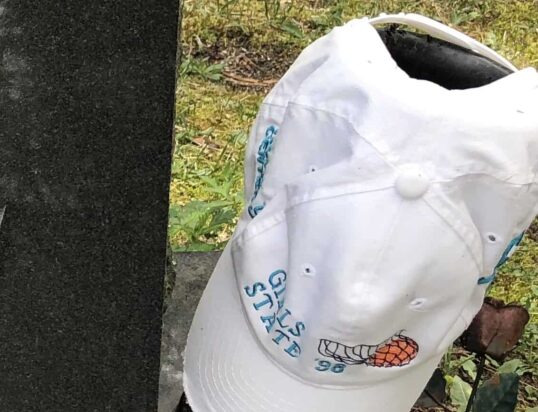My daughter Heidi flew in from California over Mother’s Day to spend time with me. Since her two boys weren’t along, we had the chance to dine out, visit Madison’s botanical garden, kayak the Wisconsin River, and have a memorial walk around the Spring Grove Cemetery.
A few years ago, my husband and I debated if we should buy cemetery plots since it seemed like a wasteful use of land. Maybe you, too, are at the point of life where you discuss this. Cremation makes sense to us—it takes up only a small space—but after talking at length, he and I decided we wanted our names on a little marker in the town we call home.
Cemeteries have value beyond burying the dead. They’re places where people can walk and get a sense of history. Wisconsin Dells’ Spring Grove Cemetery has several famous markers. Heidi and I walk past the Bennett graves. Heidi’s married name is Bennett and I, too, feel a connection since I’ve gotten to spend time with H.H. Bennett’s granddaughters, Betsy and Debbie.
We walk past a marker that tells part of the tale of the Dells’ “Bloody September.” Schuyler Gates, father of LeRoy Gates the famous Dells pilot, and his much younger wife were attacked by masked bandits. They managed to live through it, but Gates was later gunned down to avoid testifying. Relatives had the word “Murdered” carved on his marker. For intrigued readers, the Dells Historical Society’s publication, “Others Before You,” includes the full story.
One of Spring Grove’s most famous gravesites belongs to Belle Boyd, the daring, flirtatious, and famous confederate spy who died of a heart attack in the Dells in 1900 while on a speaking tour.
Besides showing history, cemeteries reveal important happenings in a community. Years ago Heidi and I walked through this cemetery and found five Native American markers, all with the same date of death. We researched the White Eagle family and discovered they’d been victims of a tragic fire. Even though the tragedy happened before I lived in the Dells and I didn’t know the family, it tugs at my heartstrings and I think of them any time I walk past.
Today, my daughter wants to pay tribute to the dear woman who helped raise her. Edie Hammerly provided excellent daycare and was famous for the awesome birthday parties she gave each of her “children.” I flashed back to one where Heidi’s sister kept looking in her birthday treat bag. I explained no more candy until after supper. Since her attention was still drawn to the bag, I took it away and discovered she’d placed a dead vole—something she’d found in the yard—in the treat bag. The memory allows me to flash back to the time when I was a young mother used to surprises such as these, and I’m grateful for that.
Heidi also asks to visit the grave of a classmate, Becky Deering, whose life met a tragic end. My husband had her as a fifth-grade student at the time of her death. We head toward the area in silence, each remembering her in our own way. I knew her from church and can picture her exuberance and how she could light up a room. Her marker reads, “A loving child who touched the lives of many and who was loved by all.” We each spend a moment with our own memories.
Heidi eventually leads the way down the hill, and it’s a few minutes later when I realize she wants to visit the grave of another classmate, Laina Bailey. I should have guessed since right before the walk, Heidi had gotten the white “Dells Girls State ’98” hat that still remained in a drawer and placed it on her head. My daughter and Laina played basketball together. Laina’s life, too, came to an end because of a tragic accident. Heidi stood at Laina’s grave a moment. Finally, she took off her hat and placed it on Laina’s grave.
The hat is a tribute to their shared time together on this small planet in the town where they spent many happy moments.
Can we justify the use of land for cemeteries? The placement of a white hat to honor a dear friend is all the answer I need.


8 Replies to “The Value of Cemeteries”
An interesting and moving take on cemeteries. They really are for the living, not the dead, and you made this point beautifully.
Thanks for your comment, Gayle, and for being a faithful follower.
I loved it
Thank you, Jane. I appreciate your comment and your following me.
A poignant article. Thanks for the ‘food for thought’.
Thank you, Flora. I’m glad the column touched you.
What a wonderful walk sharing precious memories and giving life to those who have passed..
Thank you, Debbie.